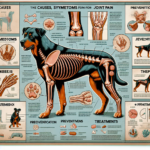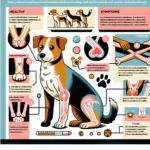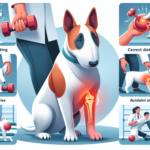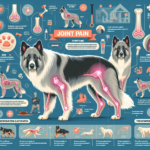Field Spaniel Joint Pain: Causes, Symptoms, Prevention, and Treatment
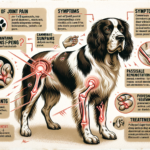
Introduction
The Field Spaniel is a medium-sized breed known for its versatility, intelligence, and affectionate nature. Originating in England during the 19th century, this breed was initially developed for hunting and retrieving game. Field Spaniels are characterized by their long, silky coats, expressive eyes, and well-balanced bodies. They are known for their gentle temperament and make excellent family pets as well as working dogs.
Like many purebred dogs, Field Spaniels are prone to certain health issues. Among these, joint pain is a significant concern that can affect their quality of life. Joint pain in dogs can stem from various causes, including genetic predispositions, age-related wear and tear, and lifestyle factors. Understanding the importance of joint health in Field Spaniels is crucial for ensuring their well-being and longevity.
Breed-Specific Joint Pain Risks
Genetic Predisposition
Field Spaniels, like many other breeds, have a genetic predisposition to joint-related issues. Common conditions include hip dysplasia, elbow dysplasia, and arthritis. Hip dysplasia is a malformation of the hip joint that can lead to pain and mobility issues. Elbow dysplasia involves abnormal development of the elbow joint, causing lameness and discomfort. Arthritis, a degenerative joint disease, can develop as a result of these conditions or independently, leading to chronic pain and stiffness.
Age-Related Risks
As Field Spaniels age, the risk of developing joint pain increases. Typically, signs of joint issues may start to appear in middle age, around 5 to 7 years old. However, some dogs may show symptoms earlier or later, depending on their genetic makeup and lifestyle. It’s essential for owners to be vigilant about their dog’s joint health as they age, as early detection and intervention can significantly improve outcomes.
Activity Level and Joint Stress
Field Spaniels are active dogs that enjoy physical activities such as running, playing, and hunting. While regular exercise is beneficial for their overall health, excessive or high-impact activities can put stress on their joints. Activities like jumping, running on hard surfaces, or intense agility training can exacerbate joint issues, especially if the dog has a genetic predisposition to such problems. Balancing activity levels and providing appropriate exercise is key to maintaining joint health in Field Spaniels.
Common Symptoms of Joint Pain in Field Spaniels
General Symptoms
- Limping or favoring one leg
- Stiffness, especially after rest or sleep
- Reluctance to move, jump, or climb stairs
- Decreased activity or playfulness
- Swelling around the joints
- Whining or showing signs of discomfort when touched
Breed-Specific Symptoms
In Field Spaniels, joint pain may manifest in specific ways due to their unique physical characteristics and activity levels. Owners may notice a reluctance to engage in activities they once enjoyed, such as retrieving or running. Additionally, the breed’s expressive nature may make it easier to detect subtle signs of discomfort, such as changes in behavior or mood.
When to Consult a Vet
If you observe any of the above symptoms in your Field Spaniel, it’s essential to consult a veterinarian promptly. Early diagnosis and treatment can prevent the progression of joint issues and improve your dog’s quality of life. Regular veterinary check-ups are also crucial for monitoring joint health and catching any problems early.
Preventive Measures for Joint Health
Exercise Recommendations
Regular, moderate exercise is vital for maintaining joint health in Field Spaniels. Activities such as walking, swimming, and gentle play are excellent options. Swimming, in particular, is a low-impact exercise that can strengthen muscles without putting undue stress on the joints. Avoid high-impact activities like jumping or running on hard surfaces, especially for extended periods.
Dietary Suggestions
A balanced diet rich in essential nutrients can support joint health. Consider incorporating foods or supplements that contain glucosamine, chondroitin, and omega-3 fatty acids, which are known to promote joint health and reduce inflammation. Consult your veterinarian for specific dietary recommendations tailored to your dog’s needs.
Weight Management
Maintaining a healthy weight is crucial for reducing joint stress. Excess weight can exacerbate joint issues and lead to more severe problems. Monitor your Field Spaniel’s weight and adjust their diet and exercise routine as needed to keep them at an optimal weight. Your veterinarian can provide guidance on appropriate weight ranges and management strategies.
Early Screening and Monitoring
Regular veterinary check-ups and early screening for joint issues can help catch problems before they become severe. For Field Spaniels, consider screening for hip and elbow dysplasia, especially if you plan to breed your dog. Early detection allows for timely intervention and can significantly improve your dog’s quality of life.
Treatment Options for Joint Pain
Non-Surgical Treatments
Non-surgical treatments for joint pain in Field Spaniels include medications, physical therapy, and lifestyle adjustments. Anti-inflammatory medications and pain relievers can help manage symptoms and improve mobility. Physical therapy, including exercises and massage, can strengthen muscles and support joint function. Lifestyle adjustments, such as providing a comfortable bed and avoiding high-impact activities, can also alleviate joint pain.
Surgical Options
In severe cases, surgical intervention may be necessary to address joint pain. Common surgical options include hip replacement, arthroscopy, and joint fusion. These procedures can provide significant relief and improve mobility, but they come with risks and require a recovery period. Consult with a veterinary orthopedic specialist to determine the best course of action for your dog.
Alternative Therapies
Alternative therapies such as acupuncture, hydrotherapy, and massage can complement traditional treatments and provide additional relief. Acupuncture involves inserting thin needles into specific points on the body to reduce pain and inflammation. Hydrotherapy, or water therapy, allows dogs to exercise in a low-impact environment, reducing joint stress. Massage can improve circulation and alleviate muscle tension, supporting overall joint health.
Lifestyle and Management Tips
Daily Care Routine
A consistent daily care routine can help manage and alleviate joint pain in Field Spaniels. This routine might include gentle exercise, a balanced diet, and regular grooming to keep their coat and skin healthy. Incorporate joint-friendly activities like swimming and avoid high-impact exercises. Monitor your dog’s weight and adjust their diet as needed to maintain a healthy weight.
Modifying the Home Environment
Making your home more comfortable for a dog with joint pain can significantly improve their quality of life. Consider adding ramps to help them navigate stairs or get onto furniture. Provide an orthopedic bed to support their joints while they rest. Ensure that food and water bowls are at a comfortable height to reduce strain on their neck and joints.
Long-Term Management
Long-term management of joint pain involves regular veterinary check-ups, ongoing monitoring of symptoms, and adjustments to your dog’s care routine as needed. Stay informed about new treatments and therapies that may benefit your dog. Maintaining a proactive approach to joint health can help your Field Spaniel live a happy, active life despite joint pain.
FAQs About Field Spaniels and Joint Pain
What are the early signs of joint pain in Field Spaniels?
Early signs of joint pain in Field Spaniels include limping, stiffness, reluctance to move, and decreased activity levels. You may also notice swelling around the joints or changes in behavior, such as increased irritability or reluctance to be touched.
Can joint pain in Field Spaniels be prevented?
While genetic predispositions cannot be entirely prevented, you can take steps to reduce the risk and severity of joint pain. These include maintaining a healthy weight, providing regular, moderate exercise, and ensuring a balanced diet rich in joint-supporting nutrients. Early screening and regular veterinary check-ups are also crucial for catching issues early.
Are there specific exercises that are better for Field Spaniels with joint pain?
Yes, low-impact exercises such as walking and swimming are ideal for Field Spaniels with joint pain. These activities help maintain muscle strength and joint flexibility without putting excessive stress on the joints. Avoid high-impact activities like jumping or running on hard surfaces.
What dietary supplements can help with joint pain in Field Spaniels?
Supplements containing glucosamine, chondroitin, and omega-3 fatty acids can support joint health and reduce inflammation. Always consult your veterinarian before adding supplements to your dog’s diet to ensure they are appropriate and safe for your pet.
When should I consider surgical options for my Field Spaniel’s joint pain?
Surgical options should be considered when non-surgical treatments are no longer effective in managing your dog’s pain and mobility issues. Consult with a veterinary orthopedic specialist to discuss the potential benefits and risks of surgery for your Field Spaniel.
Conclusion
Joint pain is a significant concern for Field Spaniels, but with proper care and attention, it can be managed effectively. Understanding the breed-specific risks, recognizing early symptoms, and taking preventive measures are crucial for maintaining your dog’s joint health. Regular veterinary check-ups, a balanced diet, appropriate exercise, and weight management are essential components of a comprehensive joint health strategy. By staying proactive and informed, you can help ensure your Field Spaniel enjoys a happy, active life despite joint pain.
Remember, always consult your veterinarian for personalized advice and treatment options tailored to your dog’s specific needs. Taking preventive measures and seeking timely veterinary care can make a significant difference in your Field Spaniel’s quality of life.

